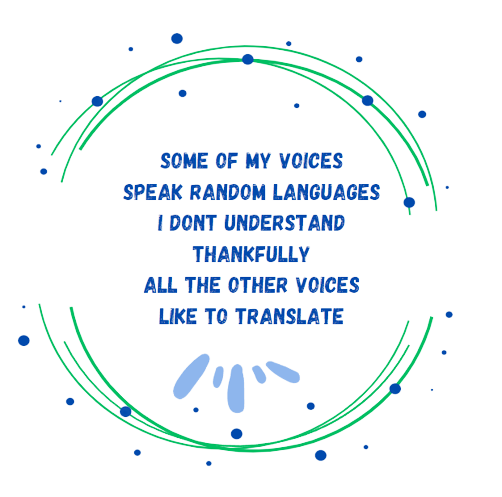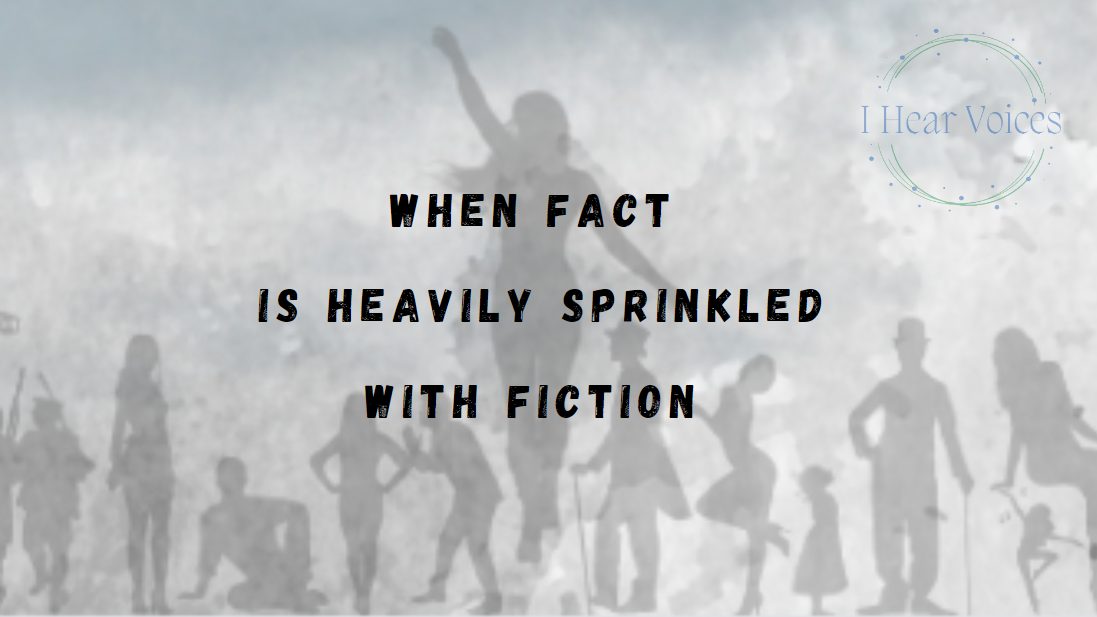Auditory hallucinations are a sensory experience characterized by hearing sounds or voices that are not actually present. It’s the posh and Royal way of describing uncontrollable voices in your head that scream and screech and abuse and preach. All day everyday. And follow you even when you hide under the bed.
These hallucinations are best known when they occur in individuals with certain mental health conditions, such as schizophrenia, schizo-affective disorder, bipolar disorder, or major depressive disorder with psychotic features. However, they can also occur in individuals without any diagnosed mental health condition. Which I imagine is just as unpleasant even though it’s the only malfunction of the mind.
Auditory hallucinations can manifest in different ways. Some people may hear voices that engage in conversations or provide commentary on their thoughts and actions. Others may experience hearing noises, such as knocking, footsteps, or music. The voices or sounds can be perceived as coming from inside the person’s head or from external sources.
The exact cause of auditory hallucinations is not fully understood, but research suggests that a combination of genetic, environmental, and neurochemical factors may play a role. In individuals with mental health disorders, such hallucinations are believed to be associated with imbalances in neurotransmitters, particularly dopamine, which is involved in regulating mood and perception.
Treatment for auditory hallucinations typically involves a combination of medication and therapy. Antipsychotic medications are often prescribed to help reduce the intensity and frequency of hallucinations. Therapy, such as cognitive-behavioural therapy (CBT) or other forms of psychotherapy, can help individuals develop coping strategies, challenge their beliefs about the hallucinations, and manage any associated distress or impairment in daily functioning.
While auditory hallucinations are typically associated with mental health conditions and can be distressing for many individuals, it is important to note that there are some individuals who may find enjoyment or creative inspiration from their auditory experiences. These experiences can occur in the absence of mental health disorders and may be seen as a form of imaginative or creative expression.
For example, some artists, musicians, or writers may report experiencing auditory hallucinations that they find inspiring for their creative work. These hallucinations could manifest as hearing melodies, voices, or sounds that contribute to their artistic process. In such cases, individuals may view their hallucinations as a unique source of inspiration and find them to be personally meaningful or enriching.
There are several well-known individuals who have publicly discussed their experiences with auditory hallucinations. Here are a few examples:
- John Nash: John Forbes Nash Jr., a renowned mathematician and Nobel laureate, struggled with schizophrenia throughout his life. He experienced auditory hallucinations as part of his condition. His life and struggles were depicted in the movie “A Beautiful Mind.”
- Vincent van Gogh: The famous Dutch painter Vincent van Gogh had a tumultuous life and is believed to have suffered from mental health issues, including auditory hallucinations. He described hearing voices and experiencing disturbances during his periods of intense creativity.
- Syd Barrett: Syd Barrett, a founding member of the rock band Pink Floyd, experienced mental health issues, including auditory hallucinations. His struggles with schizophrenia and LSD use ultimately led to his departure from the band.
- Brian Wilson: Brian Wilson, a member of the Beach Boys, has openly discussed his experiences with auditory hallucinations and mental health challenges. His struggles contributed to the creation of the album “Pet Sounds” and affected his personal life and career.
It’s crucial to differentiate between pathological hallucinations associated with mental health disorders, which typically cause distress and impairment, and non-pathological experiences that some individuals may find enjoyable or even beneficial. These non-pathological experiences may not interfere with daily functioning or cause significant distress.
However, it is important to remember that not all auditory hallucinations experienced by individuals without mental health conditions are positive or harmless. Sometimes, these experiences can be unsettling, intrusive, or disruptive to a person’s well-being. If someone is experiencing auditory hallucinations that are distressing, causing impairment, or interfering with their daily life, it is recommended to seek professional help from a mental health provider for evaluation and appropriate support.

Taking this personality confusion one step further we come to split personality disorders such as Dissociative identity disorder which take hallucinations to a whole new level.
Dissociative Identity Disorder (DID), previously known as Multiple Personality Disorder, is a complex mental health condition characterized by the presence of two or more distinct personality states or identities within an individual. These identities, often referred to as alters, can vary in their behaviour, thoughts, emotions, and memories.
Here are some key points about Dissociative Identity Disorder:
- Alters: Each alter within a person with DID has its own unique way of perceiving and interacting with the world. Alters may have different ages, genders, names, voices, and even physical characteristics. They can emerge and take control of the person’s behaviour, resulting in gaps in memory or time loss.
- Dissociation: Dissociation is a defence mechanism in which a person detaches from their surroundings, thoughts, feelings, or memories. It is a common feature of DID and serves as a way to cope with traumatic experiences. Dissociation can range from mild detachment to more severe dissociative states, where the person may lose track of time or their sense of self.
- Trauma and DID: The development of Dissociative Identity Disorder is often linked to a history of severe childhood trauma, such as physical, sexual, or emotional abuse. Trauma disrupts the normal development of identity and can lead to the fragmentation of the person’s sense of self into different identities as a way to cope with the overwhelming experiences.
- Coexistence of Alters: The different alters in a person with DID may have their own distinct memories, skills, preferences, and reactions to the world. Communication and cooperation among alters can vary, and conflicts between identities can arise, leading to internal struggles.
- Diagnosis and Treatment: Diagnosing DID can be challenging due to the complexities and secrecy surrounding the condition. It often requires a thorough assessment by a mental health professional experienced in working with dissociative disorders. Treatment typically involves long-term psychotherapy, particularly approaches such as trauma-focused therapy, cognitive-behavioural therapy (CBT), and dialectical behaviour therapy (DBT). The goal is to enhance communication among alters, integrate identities, develop coping skills, and address trauma-related symptoms.
It is important to approach discussions about Dissociative Identity Disorder with sensitivity and respect. Media portrayals of DID can sometimes be sensationalized or inaccurate, leading to misconceptions. People living with DID often face stigma and may find it challenging to access appropriate support.
Medication can be one component of the treatment plan for individuals experiencing auditory hallucinations, particularly if the hallucinations are associated with a mental health condition such as schizophrenia or bipolar disorder. The primary class of medications used to manage auditory hallucinations are antipsychotic medications. Here are some commonly prescribed medications:
- First-generation antipsychotics: These are older medications that work by blocking dopamine receptors in the brain. Examples include haloperidol (Haldol), chlorpromazine (Thorazine), and fluphenazine (Prolixin).
- Second-generation (atypical) antipsychotics: These newer medications also affect dopamine receptors but have a different receptor profile and may have fewer side effects compared to first-generation antipsychotics. Examples include risperidone (Risperdal), olanzapine (Zyprexa), quetiapine (Seroquel), aripiprazole (Abilify), and clozapine (Clozaril).
The choice of medication depends on various factors, including the individual’s specific symptoms, medical history, and any potential side effects. The dosage and treatment duration are determined by a healthcare professional and may require adjustments over time.
It’s important to note that medication alone may not completely eliminate auditory hallucinations or address all aspects of the underlying condition. Psychotherapy, such as cognitive-behavioural therapy (CBT) or supportive therapy, is often recommended in conjunction with medication to help individuals develop coping strategies, explore the meaning of the hallucinations, and manage associated distress or impairment.
Medication is not typically the primary treatment for Dissociative Identity Disorder (DID). The primary approach to treating DID involves psychotherapy, particularly trauma-focused therapy, which aims to address the underlying trauma that contributes to the development and maintenance of the disorder. However, in some cases, medication may be prescribed to manage specific symptoms or comorbid conditions that can occur alongside DID. These medications may include:
- Antidepressants: Selective serotonin reuptake inhibitors (SSRIs) or other antidepressant medications may be prescribed to help manage symptoms of depression, anxiety, or other mood-related issues that can be associated with DID.
- Anti-anxiety medications: Benzodiazepines or other anti-anxiety medications may be used on a short-term basis to help manage acute anxiety, panic symptoms, or severe distress. However, caution is required with the use of these medications due to the potential for dependence and other side effects.
- Sleep aids: Some individuals with DID may experience sleep disturbances, such as insomnia or nightmares. In such cases, short-term use of sleep medications or medications that promote sleep may be considered to help regulate sleep patterns.
It’s important to note that the use of medication for DID is typically adjunctive to psychotherapy and is focused on managing specific symptoms rather than directly treating the dissociative identity aspects of the disorder. The specific medications and their appropriateness will vary depending on the individual and their specific needs, so it is crucial to consult with a mental health professional who specializes in dissociative disorders to determine the most suitable treatment approach.
Additionally, any decision regarding medication should be made in collaboration with a healthcare professional who can provide appropriate guidance, monitor medication effectiveness and side effects, and adjust treatment as necessary.
If you or someone you know is experiencing auditory hallucinations or personality confusions and imbalances, it is important to seek professional help from a mental health provider. They can provide an accurate diagnosis, determine the underlying cause, and develop an appropriate treatment plan to address the symptoms.
‘I hear voices’ is a blog area within subwaysouls dedicated to such subjects and written within a creative story telling structure. Based on fact and real life experiences, the content of ‘I hear voices’ is sprinkled heavily with fiction and non of the content is to be taken as advice. The characters are fiction and subject content, while may be loosely based on real life experiences is developed for illustrative purposes only.

